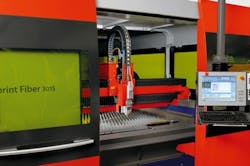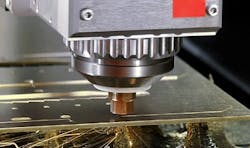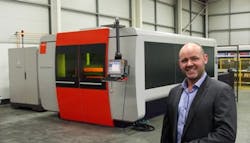By David Larcombe, managing director, Bystronic UK Limited
As a manufacturer of CO2 laser cutting machines with output power from 2.2 to 6 kW and true fiber laser machines ranging from 2 to 4 kW, Bystronic UK Limited, Coventry, UK, is often asked about the benefits of each type of machine and which is better for specific applications. As there is often some confusion in the marketplace, David Larcombe, managing director of Bystronic UK, outlines below the pros and cons of the two technologies.
This debate is so often on customers' minds, said Larcombe, that CO2 and fiber laser cutting comparisons, presentations, and live tests have been made key topics in presentations at Bystronic's last two open houses in the UK, which created lively debate.
During one discussion with a customer, Larcombe decided that instead of simply explaining the theory, it would be interesting to analyze the results and experiences of users over the last three years. During this time, more than 35 fiber laser cutting machines have been sold by the company in the UK alone.
Fiber lasers
Briefly, fiber laser light is created by banks of diodes. The light is channeled and amplified through fiber optic cable similar to that used for data transfer. The amplified light, on exiting the fiber cable, is collimated or straightened and then focused by a lens onto the material to be cut.Creation of the light is 200% more efficient than via a traditional CO2 laser, and delivery is far simpler, with no expensive optical mirrors. The focusing lens, unlike on a conventional CO2 laser machine, is sealed in the cutting head and thus not a consumable item.
Bystronic first launched its fiber laser in the UK in 2010 as a 2 kW machine, which was swiftly followed by a 3 kW and then a 4 kW machine. Interestingly, the 3 kW model remains most popular, with 60% of UK machines delivered being of this power.
If one examines the price-to-performance ratio of the different models, the main cutting speed benefit of the higher-power 4 kW laser is in mid-range materials from 6 to 8 mm thick. There are also small benefits in thickness capacity when cutting non-ferrous materials, typically an increase of one gauge of material. This helps only customers who cut a lot of material in the 6 to 8 mm range or who wish to cover all eventualities, as it is their only laser cutting machine.
The benefits of a true fiber laser source include:
1. No moving parts or mirrors in the light-generating source, unlike a conventional CO2 resonator or disk laser. This has a distinct advantage in terms of reducing maintenance requirements and operating costs.
2. Much higher electrical efficiency, resulting in considerably lower running costs. A 3 kW fiber machine uses one third of the power of a 4 kW CO2 machine of average across-the-board performance.
3. Higher speeds when cutting thin material. Compared with the same 4 kW CO2 machine, the fiber laser is three times quicker in a straight line cutting of 1 mm mild, galvanized, or stainless steel and twice as fast when cutting 2 mm.
4. An ability to cut reflective materials without fear of back reflections damaging the machine. This allows copper, brass, and aluminium to be cut without problems.
5. 50% longer servicing intervals and 50% lower servicing costs.
CO2 laserThe disadvantages of fiber compared with CO2 mainly relate to the cutting speed when processing thicker materials, typically above 5 mm, where the CO2 machine is faster in a straight line and also has much faster piercing times at the start of the cut. There is also the advantage of a smoother surface finish with the CO2 machine when cutting thicker materials.
Thus, what can be deduced from the statistics and experiences of our UK customers that have bought fiber and sometimes also CO2 laser profilers from Bystronic?
1. Over 70% of fiber laser customers are subcontractors, the remainder being original equipment manufacturers (OEMs). This is surprising, as one would expect OEMs to be more confident about deciding to purchase a fiber laser machine, where the advantages and disadvantages vary greatly, depending on the products to be cut. Subcontractors can never be sure what the next job will be and what material thicknesses will need to be processed, so theoretically the versatility of a CO2 machine would be more attractive.
2. Of the subcontractors, only 31% had a single laser profiler after purchasing the fiber machine, whereas 69% were multiple laser users and could decide which machine to put work onto, CO2 or fiber.
3. The main reason for purchasing a fiber machine was the speed of cutting thin (1 to 2 mm and up to 3 mm) materials.
4. An important secondary reason was the lower running cost and the lower power consumption using fiber technology, which was particularly important in companies at the top end of the electrical supply limit in their workshops.
CUSTOMER EXPERIENCES
FC Laser
Danny Fantom, managing director of subcontractor FC Laser, Ilkeston, UK, said that Bystronic’s managing director advised him to complement his existing 4.4 kW CO2 laser with a 3 kW fiber machine (Fig. 3). Although skeptical at first about the benefits of this technology with its lower power, Fantom decided to go ahead with the recommendation.After the fiber machine had been running alongside the CO2 facility for two months, he commented that he could honestly say that in terms of speed and quality of cut, the new machine greatly exceeded his expectations. He said that the quality of cut is very reliable without adjustment and the speed of the machine is typically twice that of their latest CO2 machine on most materials.
It has enabled the growing subcontractor to maintain fast and reliable delivery times. Moreover, the ability to process copper and brass has also been extremely useful, as this is work for which they would not have quoted in the past.
Brattonsound Engineering
Brattonsound Engineering, Sutton, UK, replaced a three-year-old, 2.2 kW CO2 laser with a 2 kW fiber laser cutting machine. The company cuts thin materials mainly up to 2 mm for its range of gas fires and gun safes.
In production, the machine exceeded expectations, with some nests of parts cut three times faster than on the old CO2 machine. Average improvement was a doubling of cutting speed. The overall quality of cut parts was as good, even with the faster cutting speeds, and more consistent quality was achieved across the entire sheet.
As predicted, running costs for the machine have also been reduced. With its solid state, highly efficient fiber power source, the electrical load has more than halved, dropping from 37 kW to only 16 kW. Furthermore, as the machine is cutting twice as fast, running costs per part produced have reduced by two-thirds, taking into account both electricity and cutting gas.
Brattonsound's Gerald Tag commented that the only problem they encounter is that before the investment, the laser operator had time to assemble kits of parts between each cutting plan, but with the new machine he does not have time to stop. As soon as a sheet is loaded, it is cut before the parts are removed from the previous sheet.
ICEE
The Waterlooville, UK, manufacturing plant of ICEE Managed Services is a leader in fabrication, enclosure products, and laser profiling. The company replaced a CO2 laser with a similarly sized 2 kW fiber machine in mid-2011. Chris Arnold, key engineering account manager at ICEE explained that the company undertakes a repeat contract to fabricate electrical enclosures for a regular customer and have always cut the material on an older 2 kW laser.
The complete order used to take just over 38 hours on that machine and, with set-ups, it would tie up the machine for the whole week. However, during the first time ICEE ran the batch on the new fiber machine, part way through Monday the operator asked the production manager what he wanted him to do next. He had completed the previous week-long order in just six hours.
This was not an isolated case. Another project in 2.6 mm copper requiring 260 holes to be cut took just 55 seconds per part. Arnold confirmed that the machine is, in his words, phenomenally quick.
WEC Group
A fiber laser CNC profiling machine was installed in January 2013 at the Darwen factory of WEC Group in Lancashire, UK (Fig. 4). It has resulted in significant cost savings when processing stainless steel sheet in the 1.5 to 4 mm thickness range. Some nests can be cut 50% faster, according to Gareth Taylor, assistant general manager of the Laser Division.Furthermore, the 3 m by 1.5 m capacity machine, WEC's first fiber laser, is able to cut highly reflective and thermally conductive materials, notably copper and brass, that CO2 lasers are not able to process without damaging the optics. The scope of WEC's service is therefore considerably extended. Even small flashbacks from aluminium can damage the lens and mirrors on a CO2 laser and so this material can also be more economically cut on the fiber machine, if the material is reasonably thin. The machine also cuts up to 20 mm thick mild steel. Further advantages of using fiber laser technology are that there is no need for expensive laser gases and electricity consumption is less, which is of ecological benefit and results in lower running costs.
Subcontract production of aircraft components is an area that WEC is seeking to expand, as it is located conveniently within the aerospace cluster in the Northwest of England, the largest such industry group in Europe. Already a supplier of non-flying components, the company is currently in the process of gaining the AS9100 quality management system for the aerospace industry. The Bystronic fiber laser, which produces very high quality cut edges with minimal heat affected zone, will be important in increasing WEC's aerospace business.
An ongoing requirement to cut thin gauge stainless steel was the main driver for investing in the fiber laser machine. It was apparent to Taylor, who has over 20 years of laser cutting experience, that big savings were possible using a fiber laser to machine this material in the thickness range of 1.5 to 4 mm.
He said that WEC cuts stainless steel up to 50% quicker, which is on the machine for about 70% of the time, 24 hours a day. The material is ideal for extracting maximum benefit from fiber lasers, so the machine will pay for itself quickly. For the other 30% of its time, the machine is available for cutting reflective metals for which the company could not previously quote. The fiber laser is already bringing in new business of this type, which the subcontractor had to turn down before.
The 3 kW fiber laser machine has a compact footprint of slightly over 10 x 6 M, a 3048 x 1524 mm cutting area and a maximum simultaneous positioning speed of 140 m/min, with axis acceleration of up to 12 m/s2. The model purchased by WEC includes an optional conveyor for small parts that runs underneath the machine from the working area to the rear of the loading table.
Conclusion: CO2 versus fiberWhat are the conclusions to be drawn from this evaluation? In summary, Bystronic UK's experience so far is that the companies most likely to adopt the new fiber technology are subcontractors, either those that specialize in cutting thin metal such as for point-of-sale sheet metal work and white goods, or firms using a fiber machine's strengths to complement CO2 laser machines cutting thicker grades of plate.
____
For more information, contact: David Larcombe, managing director, Bystronic UK Limited, 6 Wayside Business Park, Wilsons Lane, Coventry, CV6 6NY; ph 44 (0)844 848 5850, fax 44 (0)844 848 5851.



